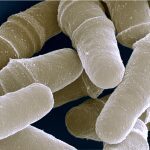Lien vers Pubmed [PMID] – 15601851
Mol. Cell. Biol. 2005 Jan;25(1):303-11
A strand-specific imprint (break) controls mating-type switching in fission yeast. By introducing a thiamine repressible promoter upstream of the mat1 locus, we can force transcription through the imprinted region, erasing the imprint and inhibiting further mating-type switching, in a reversible manner. Starting from a synchronized, virgin M-cell population, we show that the site- and strand-specific break is formed when DNA replication intermediates appear at mat1 during the first S phase. The formation of the break is concomitant with a replication fork pause and binding of the Swi1 protein at mat1 until early G(2) and then rapidly disappears. Upon its formation, the break remains stable throughout the cell cycle and triggers mating-type switching during the second S phase. Finally, we have recreated the mating-type switching pedigree at the molecular and single-cell levels, allowing for the first time separation between the establishment of imprinting and its developmental fate.

